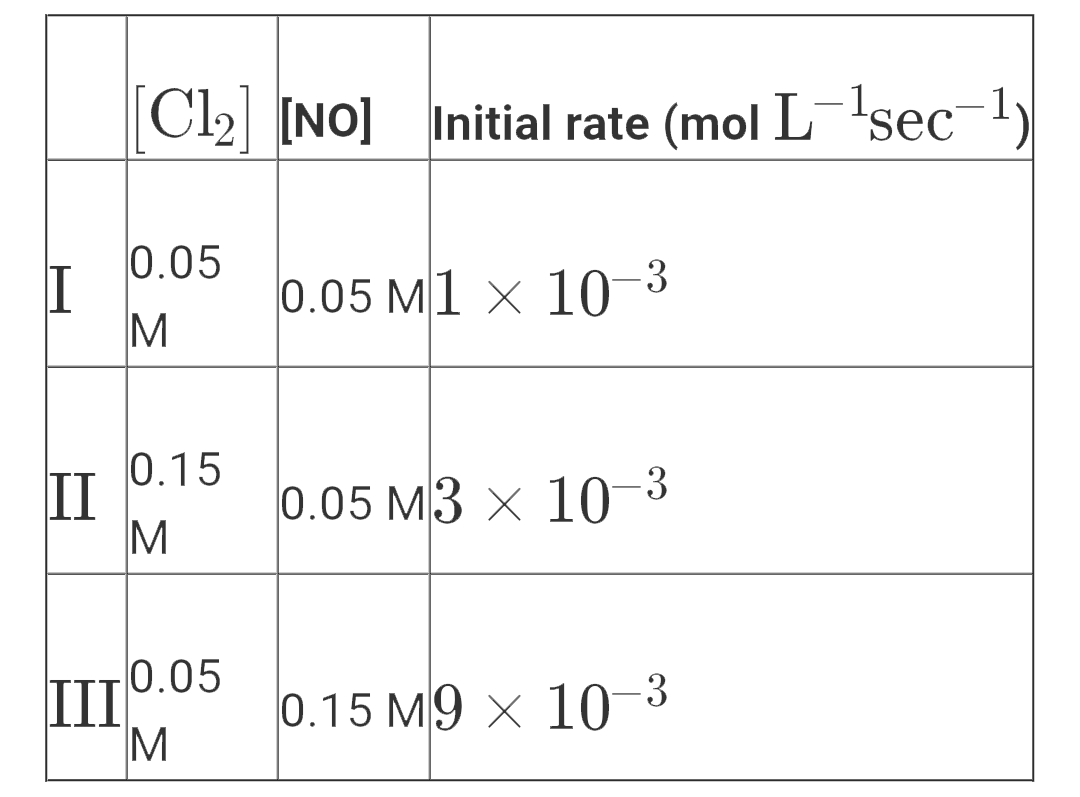Conisder the reaction mechanism:
A2keq⇐⇒2A(fast) (where A is the intermediate.)
A+B−−→k1P(slow)
The rate law for the reaction is
k1[A][B]
k1k1/2[A2]1/2[B]
k1k1/2[A][B]
k1k1/2[A]2[B]
The correct Answer is:B
To determine the rate law for the given reaction mechanism, we can follow these steps:
Step 1: Identify the Fast and Slow Steps
The reaction mechanism consists of two steps:
1. Fast Step: A2keq⇌2A
2. Slow Step: A+Bk1→P
Step 2: Write the Equilibrium Expression for the Fast Step
For the fast step, we can write the equilibrium constant expression:
Keq=(A)2(A2)
Step 3: Solve for the Concentration of the Intermediate (A)
From the equilibrium expression, we can rearrange it to find the concentration of A:
(A)2=Keq⋅(A2)
Taking the square root of both sides gives:
(A)=√Keq⋅(A2)
Step 4: Write the Rate Law for the Slow Step
The slow step is the rate-determining step, and the rate law for this step can be expressed as:
Rate=k1(A)(B)
Step 5: Substitute the Expression for (A) into the Rate Law
Now, substitute the expression we found for (A) into the rate law:
Rate=k1(√Keq⋅(A2))(B)
Step 6: Finalize the Rate Law Expression
Thus, the rate law for the overall reaction can be expressed as:
Rate=k1⋅K1/2eq⋅(A2)1/2⋅(B)
Conclusion
The final rate law for the reaction is:
Rate=k⋅(A2)1/2⋅(B)
where k=k1⋅K1/2eq.
The reaction mechanism consists of two steps:
1. Fast Step: A2keq⇌2A
2. Slow Step: A+Bk1→P
For the fast step, we can write the equilibrium constant expression:
Keq=(A)2(A2)
From the equilibrium expression, we can rearrange it to find the concentration of A:
(A)2=Keq⋅(A2)
Taking the square root of both sides gives:
(A)=√Keq⋅(A2)
The slow step is the rate-determining step, and the rate law for this step can be expressed as:
Rate=k1(A)(B)
Now, substitute the expression we found for (A) into the rate law:
Rate=k1(√Keq⋅(A2))(B)
Thus, the rate law for the overall reaction can be expressed as:
Rate=k1⋅K1/2eq⋅(A2)1/2⋅(B)
The final rate law for the reaction is:
Rate=k⋅(A2)1/2⋅(B)
where k=k1⋅K1/2eq.
Topper's Solved these Questions
- CHEMICAL KINETICSBOOK - CENGAGE CHEMISTRY ENGLISHCHAPTER - CHEMICAL KINETICSEXERCISE - Ex 4.3 (Objective)
15 Videos
- CHEMICAL KINETICSBOOK - CENGAGE CHEMISTRY ENGLISHCHAPTER - CHEMICAL KINETICSEXERCISE - Ex 4.3 More Than One Correct
5 Videos
- CHEMICAL KINETICSBOOK - CENGAGE CHEMISTRY ENGLISHCHAPTER - CHEMICAL KINETICSEXERCISE - Ex 4.1 (Objective)
9 Videos
- CARBOXYLIC ACIDS AND THEIR DERIVATIVESBOOK - CENGAGE CHEMISTRY ENGLISHCHAPTER - CARBOXYLIC ACIDS AND THEIR DERIVATIVESEXERCISE - Exercises Archives (Analytical And Descriptive)
34 Videos
- COORDINATION COMPOUNDSBOOK - CENGAGE CHEMISTRY ENGLISHCHAPTER - COORDINATION COMPOUNDSEXERCISE - Archives Subjective
18 Videos
Similar Questions
Knowledge Check
alc.KOH−−−−−−−→(K2reaction)Major product ofthe reaction is
A B
B C
C D
D
The given data are for the reaction, 2NO(g)+Cl(g)→2NOCl(g) at 298K

The rate law of the reactions is
View SolutionThe mechanism of the reaction
2NO+O2→2NO2 is
NO+NOk1⇐⇒k−1N2O2(fast)
N2O2+O2k2−−→2NO2(slow)
The rate constant of the reaction is
View SolutionThe rate law expresison is given for a typical reaction, n1A+n2B→P as r=k[A]n[B]n2. The reaction completes only in one step and A and B are present in the solution. If the reaction occurs in more than one step, then the rate law is expressed by consdering the slowest step, i.e., for SNl reaction r=k[RX]. If the eraction occurs in more than one step and the rates of the steps involved are comparable, then steady state approximation is conisdered, i.e., the rate of formation of intermediate is always equal to the rate of decompoistion of the intermediate. Conisder the reaction:
⎡⎢ ⎢⎣I2k2⇐⇒k12I(rapid equilibrium)H2+2Ik3−−→2HI(slow)⎤⎥ ⎥⎦
If we increase the concentration of I2 two times, then the rate of formation of HI will
View SolutionThe rate law expresison is given for a typical reaction, n1A+n2B→P as r=k[A]n[B]n2. The reaction completes only in one step and A and B are present in the solution. If the reaction occurs in more than one step, then the rate law is expressed by consdering the slowest step, i.e., for SNl reaction r=k[RX]. If the eraction occurs in more than one step and the rates of the steps involved are comparable, then steady state approximation is conisdered, i.e., the rate of formation of intermediate is always equal to the rate of decompoistion of the intermediate. Conisder the reaction:
⎡⎢ ⎢⎣I2k2⇐⇒k12I(rapid equilibrium)H2+2Ik3−−→2HI(slow)⎤⎥ ⎥⎦
Which of the following expresison is correct?
View SolutionThe forward reaction rate for the nitric oxide-oxygen reaction
2NO+O2→2NO2 has the rate law as:
Rate=k[NO]2[O2].
If the mechanism is assumed to be:
2NO+Okeq⇐⇒ , (rapid equilibration)
N2O2+O2k2−−→2NO2 (slow step),
then which of the following is (are) correct?
(I) Rate constant =keqk2 , (II) [N2O2]=keq[NO]2
(III) [N2O2]=keq[NO] , (IV) Rate constant =k2
The correct option is
View SolutionMechanism of the reaction is:
Ak1−−→B,2Ak2−−→C+D
What is −d[A]dt ?
View SolutionThe depletion of ozone involves the following steps :
Step 1 : O3K2⇐⇒K1O2+O (fast)
Step 2 : O3+O−−→K2O2 (slow)
The predicted order of the reaction will be
View Solution
